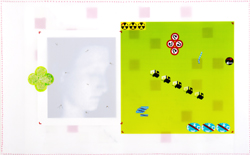|
Review
By David Roth, Square Cylinder
 |
"Lucia Revealed ", pigment print in light box
|
| |
|
The strangest most beguiling show
on view this month comes from
Mary Hull Webster. A former critic
well known to Bay Area readers,
Webster is a multi-media artist
whose application of hermetic
practices to contemporary art
making has percolated just beneath
the radar of wide public notice. Her
inner-directed, alchemy-influenced
work includes one of the trippiest,
most complex Internet art projects
you’re likely to see, Looking for
Lucia: A Book of Night Day.
Its dominant theme, "the global
light-dark imbalance," extends to
the photos, books, paintings,
sculptures on view here. Made
over a ten-year period, they focus
on the spiritual journey of two
fictional characters, Lucia and
Hugo, who, judging from the text
of an accompanying artist’s book,
may well be stand-ins for the alter
egos of Webster herself.
In that book, time, narrative viewpoints, and chronology shift so rapidly, the only
persistent “fact” is the fluid nature of the artist’s self-inventions. Fittingly, the
centerpiece of this show is the appropriated image of Hugo Ball, which Webster repeats
across a series of altered photos that portray the Hugo/Lucia character androgynously and
in conventional gender roles. For a shape-shifting artist like Webster, the character of
Ball must have been irresistible.
In 1916, he launched the Dada movement in Zurich, and though his involvement lasted a
mere two years, his influence continues to resonate, particularly at cultural moments
when things stop making sense. That same year, he co-founded Cabaret Voltaire where,
dressed in outlandish costumes, he performed “sound poetry” comprised of guttural
"Lucia Revealed", pigment print in light box
noises and nonsense phrases designed to capture the insanity of the times. Audiences,
expecting song and dance routines, were rudely awakened.
Webster first began working with Hugo/Lucia images
in 2001, and the decision to extend her involvement
with them happened last year as she was trying to
develop works about the tenth anniversary of 9/11.
“When I thought about the incoherence of it all, the
only thing that came to mind was Dada,” she told
me. By that, the artist doesn’t mean that conditions in
post-9/11 America in way rival the devastation seen
in Europe after WW I – only that irrationality persists
on a global scale.
In Webster’s re-casting of the performer’s image, he
appears clad in his freakiest, most provocative outfit:
a cubist-inspired cardboard suit, a cone-shaped hat
and gloves that make his fingers look like reptilian
claws. The image calls to mind hooded inquisitors,
wizards, magicians, clerics, Klansmen and 16th
century pilgrims. As Hugo’s partner, the Lucia
character appears in and out of costume, clothed and
naked and occasionally, with her face obliterated,
looking as if her entire being had been atomized. The
most riveting of these male/female juxtapositions
appear side-by-side, in two life-sized light boxes that
give the twin visages the ghostly presence of 19th
century “spirit photographs”.
Elsewhere in the show, there are illuminated boxes on
the floor covered with mystical symbols and rocks; a
quartet of small abstract paintings; stacks of wrapped
boxes; solarized landscape photos; books created by
Webster and three other artists (Mary Mountcastle Eubank, Louise Pryor, Zea Morvitz);
object-filled boxes (Portable Stories) whose titles and contents make sharp political
statements; and two wall-mounted sculptures, one of which suggests an
electrocardiogram made of indecipherable hieroglyphic inscriptions.
What all this means is impossible to say. Ball himself sought nothing less than to create a
language unheard of, and maybe that’s the point. As the Cabaret Voltaire co-founder
wrote: "I don’t want words that other people have invented… I want my own stuff, my
own rhythm, and vowels and consonants too, matching the rhythm and all my own. If this
pulsation is seven yards long, I want words that are seven yards long." Webster, in this
exhibit, provides plenty of visual equivalents.
Mary Hull Webster @ b. sakata garo through March 3, 2012.
|

